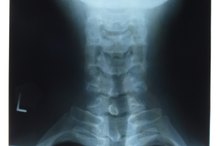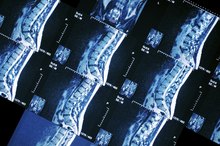What does fact checked mean?
At Healthfully, we strive to deliver objective content that is accurate and up-to-date. Our team periodically reviews articles in order to ensure content quality. The sources cited below consist of evidence from peer-reviewed journals, prominent medical organizations, academic associations, and government data.
The information contained on this site is for informational purposes only, and should not be used as a substitute for the advice of a professional health care provider. Please check with the appropriate physician regarding health questions and concerns. Although we strive to deliver accurate and up-to-date information, no guarantee to that effect is made.
What Do White Spots on a Bone Scan Indicate?
A bone scan is a test used to find areas of variable bone metabolism (increased or decreased). Bone metabolism is the process of bone tissue cells dying and being replaced. Bone scans are nuclear imaging tests that are used to track and diagnose various bone diseases. Bone scans are also called scintigraphy or musculoskeletal imaging. White spots in a bone scan indicate improper bone metabolism and can result from a number of conditions.
If you are experiencing serious medical symptoms, seek emergency treatment immediately.
Why is it Done
Doctors order bone scans related to a number of conditions and complaints, including Paget's disease, bone cancer, cancer that has (or might have) metastasized, joint infections, joint replacements and unexplained bone pain, according to the Arizona Health Sciences Center 2. If white spots show up in the scan, they can be a sign of one of these conditions.
Procedure
Abnormal Bone Scan Results
Learn More
Before a bone scan, your doctor will inject you with a radioactive material (a radioactive tracer) that will circulate through your body and will be picked up by the camera. The patterns of how the radioactive material collects in your bones can indicate a number of different diseases or injuries. In a healthy person, the radioactive material will be dispersed evenly throughout the body. If there is a problem, the material will collect in the bone at the site of the problem, showing up as white spots, according to Health and Age.
- Before a bone scan, your doctor will inject you with a radioactive material (a radioactive tracer) that will circulate through your body and will be picked up by the camera.
- If there is a problem, the material will collect in the bone at the site of the problem, showing up as white spots, according to Health and Age.
What White Spots Reveal
If a bone scan comes back with white spots it means your bones are not metabolizing properly. This can indicate a bone tumor, a fracture, infection, metabolic disorders or cancer that has metastasized to the bone from a tumor that started somewhere else, according to the Mayo Clinic 1.
Results
Side Effects of a Bone Scan
Learn More
While bone scans are very good at finding where bone problems lie (as indicated by the white spots), it is often not possible to determine the cause of the problems without further tests and/or a full patient medical history, according to the Mayo Clinic 1. A bone scan that reveals white spots will often lead a doctor to order further imaging tests including a computerized tomography scan or a magnetic resonance imaging test. The doctor might also order a biopsy of the bone to test for cancer.
- While bone scans are very good at finding where bone problems lie (as indicated by the white spots), it is often not possible to determine the cause of the problems without further tests and/or a full patient medical history, according to the Mayo Clinic 1.
- A bone scan that reveals white spots will often lead a doctor to order further imaging tests including a computerized tomography scan or a magnetic resonance imaging test.
Dangers
Despite the alarming sounding radiation injection, bone scans are quite safe, according to doctors at the Arizona Health Sciences Center 2. There is very little radiation, and it is easily metabolized by your body in the days after the procedure. Even if the material does collect in the bones, indicating a problem, it will still eventually dissipate. There is, however, a risk to pregnant women, who should not undergo bone scans unless the risks of not doing so outweigh the risks to the fetus. The radioactive material can cause birth defects.
- Despite the alarming sounding radiation injection, bone scans are quite safe, according to doctors at the Arizona Health Sciences Center 2.
- There is very little radiation, and it is easily metabolized by your body in the days after the procedure.
Related Articles
References
- Mayo Clinic: Bone Scan
- Arizona Health Sciences Center: Radiation Helps Doctors Reveal Hidden Illness
- Van den wyngaert T, Strobel K, Kampen WU, et al. The EANM practice guidelines for bone scintigraphy. Eur J Nucl Med Mol Imaging. 2016;43(9):1723-38. doi:10.1007/s00259-016-3415-4.
- Hahn S, Heusner T, Kümmel S, et al. Comparison of FDG-PET/CT and bone scintigraphy for detection of bone metastases in breast cancer. Acta Radiol. 2011;52(9):1009-14. doi:10.1258/ar.2011.100507.
- Ohta M, Tokuda Y, Suzuki Y, et al. Whole body PET for the evaluation of bony metastases in patients with breast cancer: comparison with 99Tcm-MDP bone scintigraphy. Nucl Med Commun. 2001;22(8):875-9. doi:10.1097/00006231-200108000-00005.
- Cunha JP. Myoview side effects. Updated August 29, 2019.
- National Library of Medicine. Technetium Tc 99m Bicisate. 2006.
- RadiologiyInfo.org. Bone scan (skeletal scintigraphy). Updated March 1, 2018.
- Brenner, A.; Koshy, J.; Morey, J. et al. The Bone Scan. Sem Nuclear Med. 2012;42(1):11-26. DOI: 10.1053/j.semnuclmed.2011.07.005.
- Tateishi, U.; Gamez, C.; Dawood, S. et al. Bone metastases in patients with metastatic breast cancer: morphologic and metabolic monitoring of response to systemic therapy with integrated PET/CT. Radiology. 2008;247:189-96. DOI: 10.1148/radiol.2471070567.
- U.S. Food and Drug Administration. Highlights of Prescribing Information: Technetium Tc 99m Sulfur Colloid Injection. Silver Spring, Maryland; updated July 2011.
- Wyngaeart, T.; Strobel, K.; Kampen, W. et al. The EANM practice guidelines for bone scintigraphy. Eur J Nucl Med Mol Imaging. 2016;43:1723-38. DOI: 10.1007/s00259-016-3415-4.









